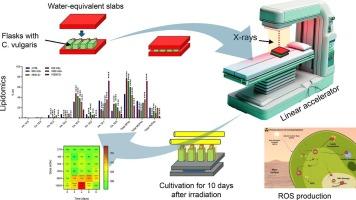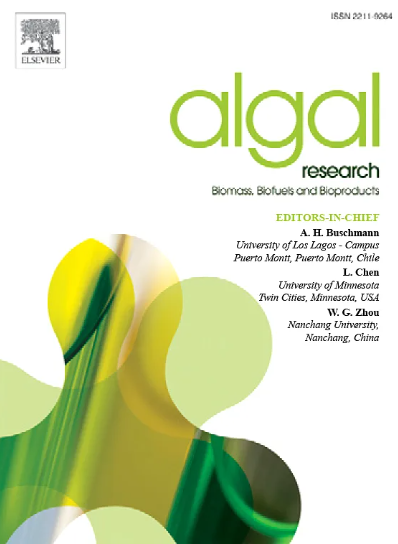低剂量 X 射线辐射对绿藻脂质体的影响
IF 4.6
2区 生物学
Q1 BIOTECHNOLOGY & APPLIED MICROBIOLOGY
Algal Research-Biomass Biofuels and Bioproducts
Pub Date : 2024-10-30
DOI:10.1016/j.algal.2024.103783
引用次数: 0
摘要
C. vulgaris 是一种微藻,具有作为人类在火星长期太空任务中营养所需的脂质和必需脂肪酸来源的巨大潜力。然而,人们对类似火星的辐射对脂质组成的影响仍然知之甚少。在本研究中,我们分析了 X 射线对 C. vulgaris CCALA 269 生长和脂质生物合成的影响,将培养物暴露于 450、900、1800、3600 和 10,800 mSv 的剂量下,分别模拟暴露于火星辐射下约 354、709、1417、2835 和 8504 天。结果表明,虽然生长保持稳定,但超过 1800 毫西弗的剂量会导致特定脂类的生成增加,这表明存在一种对抗辐射压力的适应机制。这种适应伴随着活性氧(ROS)的增加和色素组成的变化,叶绿素-a和叶绿素-a增加,叶绿素-b减少。我们的研究结果表明,C. vulgaris 具有适应电离辐射的能力,突出表明它适合在地外环境中进行可持续的脂质生产,通过原位资源利用支持火星上的人类生活。本文章由计算机程序翻译,如有差异,请以英文原文为准。

Impact of low-dose X-ray radiation on the lipidome of Chlorella vulgaris
C. vulgaris is a microalga with great potential as a source of lipids and essential fatty acids for human nutrition during extended space missions to Mars. However, the effects of Mars-like radiation on lipid composition are still poorly understood. In this study, we analyzed the effects of X-rays on the growth and lipid biosynthesis of C. vulgaris CCALA 269, exposing the cultures to doses of 450, 900, 1800, 3600, and 10,800 mSv, simulating approximately 354, 709, 1417, 2835, and 8504 days of exposure to Martian radiation, respectively. The results show that, although growth remained stable, doses exceeding 1800 mSv led to an increased production of specific lipid classes, suggesting an adaptive mechanism to counteract radiation stress. This adaptation was accompanied by an increase in reactive oxygen species (ROS) and changes in pigment composition, with an elevation in pheophytin-a and chlorophyll-a, and a decrease in chlorophyll-b. Our results demonstrate the ability of C. vulgaris to adapt to ionizing radiation, highlighting its suitability for sustainable lipid production in extraterrestrial environments, supporting human life on Mars through in situ resource utilization.
求助全文
通过发布文献求助,成功后即可免费获取论文全文。
去求助
来源期刊

Algal Research-Biomass Biofuels and Bioproducts
BIOTECHNOLOGY & APPLIED MICROBIOLOGY-
CiteScore
9.40
自引率
7.80%
发文量
332
期刊介绍:
Algal Research is an international phycology journal covering all areas of emerging technologies in algae biology, biomass production, cultivation, harvesting, extraction, bioproducts, biorefinery, engineering, and econometrics. Algae is defined to include cyanobacteria, microalgae, and protists and symbionts of interest in biotechnology. The journal publishes original research and reviews for the following scope: algal biology, including but not exclusive to: phylogeny, biodiversity, molecular traits, metabolic regulation, and genetic engineering, algal cultivation, e.g. phototrophic systems, heterotrophic systems, and mixotrophic systems, algal harvesting and extraction systems, biotechnology to convert algal biomass and components into biofuels and bioproducts, e.g., nutraceuticals, pharmaceuticals, animal feed, plastics, etc. algal products and their economic assessment
 求助内容:
求助内容: 应助结果提醒方式:
应助结果提醒方式:


